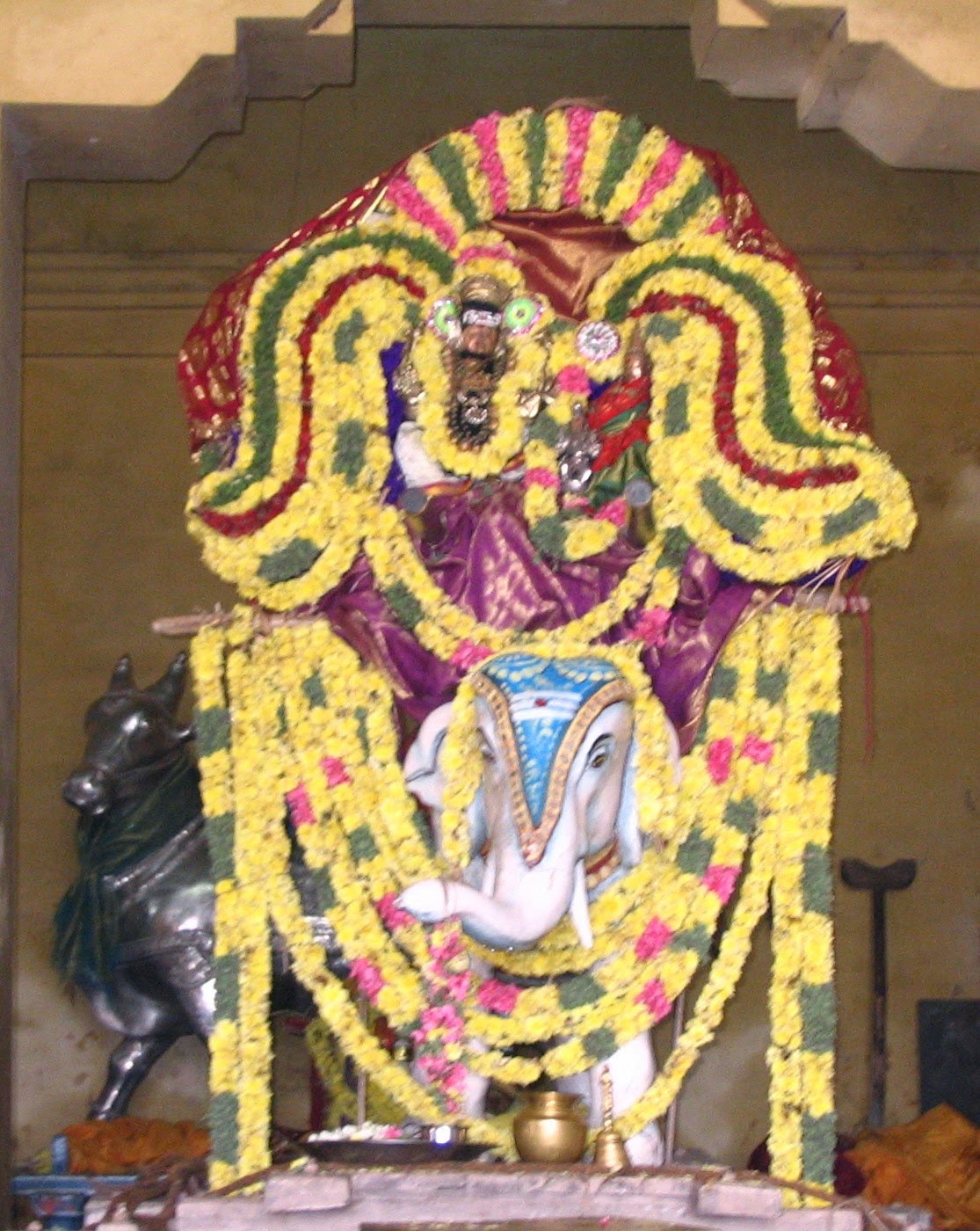The journey from Mayiladuthurai to Poompuhar on the northern bank of the river covers a distance of about 25 km. The first leg of the visit on Mayiladuthurai- Poompuhar road starts with an unique "dharshan" of Medha Dhakshinamurthi at Sri Vadhanyeswara Swami Temple on the northern outskirts of Mayiladuthurai, close to Seerkazhi road. This part of the town is called as "Uththara Mayuram"in the Puranam.
When the Holy Bull thought with an ego that it was carrying the Lord, it was asked to do penance on the northern bank of Cauvery, Shiva appeared in front of the Bull along with Ganga Devi and blessed it on an Amavasya day in the Tamil month of Aipasi and blessed. Hence the Ghat here is called, Rishabha Ghat and usually called as Thula Ghattam. During the festive month of Thulam ( Aipasi), The Lord , Medha Dhakshinamurthi, seated on silver "kailasa Vahanam", followed by Ganga Devi on Crocodile Vahanam gives Dharshan to all devotees every year. People take bath in Cauvery during this unique event.
On the last day of the month, The Lord ,in the form of Somaskandha Murthi, flanked by Gnanambikai , Ganapathi, Subramanya and Chandikeswara give "Theerthavari" in the river. The Temple of Vadhanyeswarara ,usually called as "Vallalar Koil"faces west and on the Deva Ghoshta, we have dharshan of Sri Medha Dhakshinamurthi with Nandhi in font of Him. The sannadhi draws good crowd on Thursdays and in the Tamil month of "Karthigai" when Mahabhishekam is conducted for Medha Dhakshinamurthi.
When we proceed towards Poompuhar we find many villages close to the main road, each one of them having a historic Temple. The Temples of Pasupatheeswara at Pasupathi Agraharam and the one at Karum Kuyil Nathan Pettai are about 3 km from Mayiladuthurai. On the outskirts of Manakkudi, we find a temple,renovated in the recent past,situated very close to the road. Though small in size, the Temple dedicated to Sri Sivakamasundhari sametha Sri Chidambareswarar presents a serene atmosphere with a good garden having many species of plants. Sri Sundhareswarar Temple is another one to be visited in Manakkudi.
Proceeding further for about 4 km, we arrive at a village called "Kanja Nagaram", a big village having Temples dedicated to Vishnu, Mariamman and Subramanya besides an imposing Temple for Lord Shiva. Though the Raja Gopuram is not there, the Temple is located in a sprawling site of the village. Both the Goddess Sri Thungabala Sthanambika and Sri Garthra Sundhareswara are tall deities , occupying separate sannadhis. Swami sanadhi, facing west has a big vimanam above the sanctum.
This village is associated with Manakkanjara Nayanar, one among the 63 Nayanars praised by Sri Sundhara Murthi Nayanar in his Thevaram Hymn.Therefore the village was named after him as Kanja nagaram. We can see the deities of Manakkanjara Nayanar, his wife( called Kalyana Sundhari ), his daughter (called as Punya Vardhini) along with her husband, Eyarkon Kalikkaama Nayanar, another Nayanar,celebrated by Sundharar. The story of how Lord Shiva blessed both Manakkanjarar and his family is given in detail by Sekkizhar in his outstanding work, Periapuranam. The same story is narrated at another place known as Anandha Thangdavapuram ( called as Kanjaru in Puranam) , some 5 km northwest of Mayiladuthurai. Panchavateeswarar Temple of this place is also having deities of Manakkanjarar and his family.Consecration is being planned for Gartha Sundhareswarar Temple in the coming year.
When we take a round of the sannadhis, we notice steps taking us to Sattanatha swami sannadhi on top. A dancing Ganapathi gives dharshan at the beginning of the foot steps.
The Subramanya Temple of Kanja nagaram is not far away from Gathra Sundhareswara Temple. Sri Subramanya, seated on a peacock, flanked by Valli and Deivaanai occupies the sanctum. A Shiva Lingam in Mahamandapam called "Paapa hareswarar " and Kasi Visvanatha in the outer Prakaram are important Siva sannadhis of this Temple. The shrine carries a newlook as it was renovated and consecrated quite recently.
On travelling further, we reach Karuvazhakarai , a famous pilgrim centre dedicated to the Goddess Mariamman,now called as Kamakshi. On the outskirts of this village starts another village called Marudur. One has to visit Sri Raja Rajeswara Swami Temple of this place to believe how best a good garden with so many species can be maintained well in the Temple complex. Name any tree or flower dedicated to Lord Shiva, we can see them here all due to the tireless effort of the Sivacharyar who deserves praise from one and all. The Temple was consecrated during last year but still awaits people in good numbers which alone can bring development . The locals should also support it so that it will boost the enthusiasm exhibited by the Sivacharyar.He can be contacted on 09597437157 to give prior intimation of your visit.
Vennai Eswaran Koil and Swayambunatha Swami Temple are at Melapathi , another village close by. The other Temples located at Manigramam, Thiruvenkadu, Keezha Peumpallam, Melap Peumpallam, Thalaich Sangadu, Chayavanam, Pallavaneeswaram ,Kadaimudi(Keezhaiyur)are not to be missed before reaching Poompuhar where the river Cauvery enters the sea.













.JPG)
.JPG)
.JPG)
.JPG)
.JPG)
.JPG)
.JPG)
.JPG)
.JPG)

.JPG)